Let's Make it (Email) Official
Become an AuthenTEAK Insider and be first to know about new collections, exclusive sales, and special offers.
Let's Make it (Email) Official
Become an AuthenTEAK Insider and be first to know about new collections, exclusive sales, and special offers.

Outdoor kitchen and grill experts weigh in on what’s important to consider when purchasing an outdoor grill.
Gas grills are a quintessential fixture of outdoor cooking and entertaining thanks to their convenience, versatility, and efficiency. Not only do gas grills fire up quickly, offering an instant, reliable, and easy-to-control heat, but they also require relatively minimal cleanup. Thanks to innovations within the industry, there’s also an abundance of add-ons and accessories that allow gas grills to perform different cooking methods and produce a variety of flavors. Trusted brands such as Alfresco, Lynx, and Hestan offer commercial-quality, high-performance grills that can easily be built into a complete outdoor kitchen experience.
Whether you’re planning to grill for a crowd every Saturday or you’re a grilling novice hoping to whip up the occasional weeknight burger, there’s no shortage of qualifications to consider when choosing the right outdoor grill. With so many options, we spoke with the experts to determine what you need to know and look for when selecting an outdoor gas grill that will serve you for decades to come.

Gas grills from various brands and price points might appear similar, but—much like when comparing cars—the difference between a luxury, high-performance grill that will last for decades (and potentially for a lifetime) and one that won’t is all in the details.
High-performance luxury grills offer top-of-the-line quality, performance, features, and longevity. “It’s important to have the best of the best, especially when it comes to grills because you got so many things that are sensitive outdoors,” explains Dale Seiden, whose background in high-end commercial kitchen design and equipment manufacturing led him to found Lynx Grills and Alfresco Grills.
Experts agree that a well-made, high-performing grill from a reputable brand is a true investment. “I use the term ‘ultra-luxury,’ which has to do with the styling, the quality, and the performance,” Seiden says. “Most mid-range grills come from overseas, and you don't always know what materials or quality you’ll get. Sometimes, you get a grill that looks very similar to a very high-end one, but they’re just not as effective. You have to get into the nitty-gritty of it; look in the firebox, look at the burners, look at the gauges.”
“I think there is an absolute difference in build quality,” says Urban Bonfire’s co-founder and president, Ryan Bloom, who has a background in grill and appliance retail. “Things like welds, the quality of burners, and the quality of heat retention. The sheer weight and volume of a product have a meaningful impact on heat distribution and heat retention. If you think about the physical dynamics of a grill, the more stainless steel and the more weight you have, the more it will retain heat, not just in the grill surface but also in the hood. That all contributes to cooking performance.”

Before diving into the grill-buying process, it’s important to take stock of your lifestyle and your outdoor space. “I think the big question always is, ‘What are your expectations for your outdoor area?’ says Manny Gardo, Senior Regional Sales Manager at Pinnacle Sales Group, which provides sales, distribution, after-sales support, and marketing services for luxury kitchen, bath, and outdoor living brands. “Some customers are going to grill maybe on the weekend, some will grill all the time, and some are planning to host a party every month with hundreds of guests.”
Gardo also advises taking stock of what and how often you plan to grill. “I've had people tell me, ‘I do everything outdoors; I don't even touch my indoor kitchen. And I've had people say, ‘I just occasionally like to be able to cook a steak outdoors.’ That makes a big difference in the selection process.” For some customers, a simple but high-quality freestanding gas grill might be the best choice, while others may need a fully equipped outdoor kitchen.
Freestanding gas grills are portable gas grills built on wheeled carts. Because they’re mobile, these are a great choice for smaller spaces or if you’re looking for something you can store away in the winter or take with you when you move. Freestanding grills can also range in size to suit a variety of applications and are often the choice when a full outdoor kitchen isn’t needed or in budget. “Freestanding grills are typically the go-to when cost-savings or space-savings is the goal,” says Gardo. However, “Many freestanding grills from Alfresco, Lynx, and Hestan can also be removed from the cart and used as a built-in if you change your mind,” he adds.
Built-in gas grills are specifically designed to be built into an outdoor kitchen island. Because they’re often part of a larger outdoor kitchen configuration, built-in grills become a fixture of a house and can increase property value, and also offer an efficient use of space. “I tell folks that if you’re going to entertain a lot, you want to have an area to go to, and you're not planning on changing that area, it typically pays off to do a built-in,” says Gardo.” Fully appointed outdoor kitchens are becoming increasingly popular not only for their entertainment value but also for the value they add to the home. “Now that the outdoor kitchen is becoming such an extension of your home, having a built-in grill and an outdoor kitchen is a huge advantage,” Seiden says.
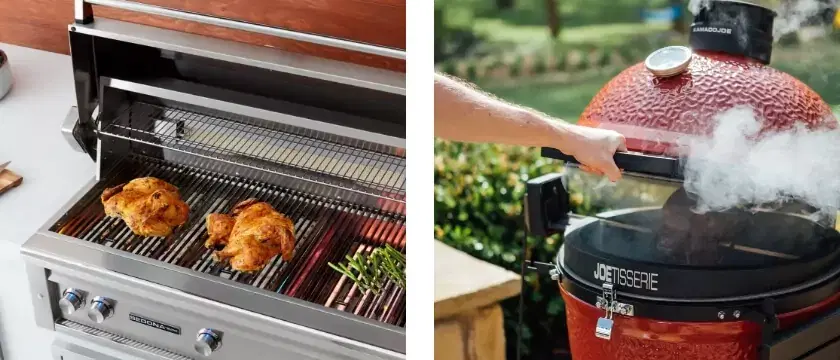
Gas grills are generally quick and easy to use, while charcoal grills are more time-consuming and impart a smoky flavor into food. (Think weeknight convenience versus a weekend slow-roast.)
When comparing gas grills to charcoal grills, “a gas grill is about speed, efficiency, and being easy to clean,” says Seiden.
Gardo agrees. “The nicest thing about a gas grill is basically start-up time,” he says. “Most professional gas grills are hot and ready to go in 10 or 20 minutes. You’re typically cooking in a lot less time, and you don’t have to worry about the cleanup of a charcoal grill, which is much more involved.”
There’s also a difference when it comes to flavor, Seiden notes. “Do you like the smoky flavor of a charcoal grill—and do you like cooking for long periods of time so that you can really drive the smoke into the food?” If so, a charcoal grill may be for you. Conversely, “[Gas] grilling is all about caramelizing and creating your own flavor with your heat delivery system,” he says. “There are also drop-in charcoal vessels or smoker drawers that you can add to a gas grill to achieve that smoky flavor.”
That’s not to say it’s a one-over-the-other situation. “The trend I see a lot is people have a gas grill so they can do their quick preps, but when they want to slow-cook a brisket, they still have a charcoal grill or a smoker of some sort,” Gardo says.
Gas grills run on two fuel types: natural gas and liquid propane. The cooking experience for each fuel type is virtually the same, but the maintenance and pricing can be different, so it’s important to consider each before making a decision. When shopping for grills through AuthenTEAK, you’ll be able to choose either natural gas or liquid propane for your fuel type. (Read about the best propane grills for the outdoors.)
Natural gas grills must be connected to a fixed natural gas line by a professional. This limits the mobility of your grill (if you’re opting for a built-in grill, this, of course, won’t be a problem); however, unlike propane grills, your grill never runs out of gas (as long as your gas bill is paid). You’ll need to pay for the up-front installation cost of a gas line, but generally speaking, natural gas grills are more cost-efficient than their propane counterparts.
Propane gas grills are fueled by standard propane tanks (which are available at most grocery stores). For reference, on a medium-sized grill, one 20-pound propane tank will typically last between 18-20 hours. Unlike natural gas grills, propane gas grills must be refilled periodically, but the benefit of propane grills is that they are more mobile than natural gas grills. A whole-house propane tank is also an option for some gas grills. These can be used for heating homes, as well as various appliances. Liquid propane tanks may also be used for built-in grills if a natural gas line isn’t available or desired.

A grill ignition type refers to the method or system used to start the burners and ignite the gas in a gas grill. The type of ignition can impact the ease, efficiency, reliability, and upkeep of starting the grill. Hot surface or spark ignitions are popular and efficient choices. The most common ignition types to look out for are:
Hot surface ignition: This type of ignition uses electricity to heat a ceramic or metal element, which ignites the gas when you turn on the grill. Hot surface ignition is highly reliable and efficient and functions well in a variety of weather conditions.
Continuous spark ignition: A continuous spark ignitor generates a constant electric spark until the grill burner lights. This ignition type requires electricity or batteries to operate. It’s also a very durable and efficient ignition method and is less prone to wear and tear than single-spark ignition.
Single Spark Ignition: This system uses an electric spark generator to produce a single spark and light the burner. This system doesn’t require an external power source and is usually operated by a button or burner knob.
Flame thrower ignition: As the name implies, this type of ignition uses a piezoelectric spark element and a concentrated stream of gas to light a small tube directed towards a burner and produce flames. This ignition type requires no electrical source and is very straightforward and reliable.
Match Light Ignition: This basic ignition type involves manually lighting burners with a match or a lighter.
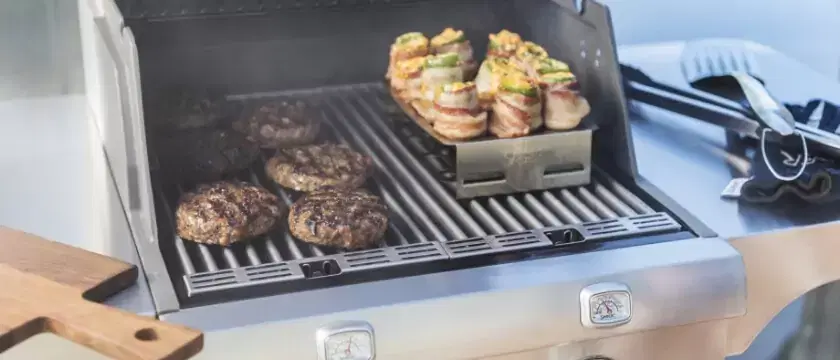
The size of your gas grill and the number of burners your grill has will determine how much food you can prepare at once. Larger grills usually have quicker cook times and more burners, which offers more cooking “zones.”
When choosing a grill size, measure the area where you plan to place your grill—or where you’d like to build your outdoor kitchen or island. Ensure there's enough room for the grill as well as any grilling accessories, storage carts, cabinetry, or kitchen equipment you may need. Also consider space for foot traffic, food prep, and maintenance.
Assess your cooking needs: How many people do you typically cook for? And how often will you be using your grill? How much surface area will you need?
“Let's say you're making eight burgers for the average family of four. You can typically do that on two burners,” says Gardo. “When you talk about a 30-inch grill, you're fine. Where you really need a larger grill is if you’re cooking for more folks or you want to use a burner for a griddle or for a sear. I think part of the allure of a bigger grill is how many burners there are and the ability to do more things with that. Generally, I would say the majority of folks are buying a 36 or 42-inch grill nowadays.”
Depending on your needs, there are a variety of grill sizes available. AuthenTEAK carries grills as petite as 20 inches and as large as 56 inches.

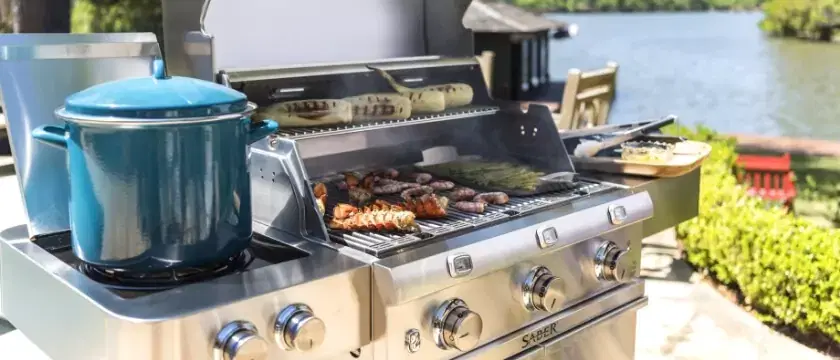
BTU stands for British Thermal Units and is a measure of how much heat a grill can produce. The BTU of your gas grill is a reflection of the total heat output of all burners per hour. Higher BTU ratings generally indicate that a grill can reach and maintain higher temperatures more quickly.
When looking at BTUs, consider how often you’ll be cooking on your grill and how much food you’ll be cooking. Smaller grills will often have lower BTUs (and likely longer cook times), while larger grills will have higher BTUs and might be more suitable for cooking at a high volume more often.
The temperature of a gas grill refers to the actual heat level the grill reaches during cooking. A fuel-efficient grill can reach high maximum temperatures with a fairly low BTU count. When it comes to the relationship between BTUs, temperature, and cook time, finding the perfect balance might take trial and error.
“If you're used to cooking with 20,000 BTUs, and now you're going to 27,500, there's a little bit of a learning curve there,” says Gardo. “It’s like when you upgrade to a new oven that’s convection; people don't realize that a family recipe from 30 years ago probably requires different cook times now that the oven is definitely heating up quicker and more evenly. The same goes for higher BTUs.”
It’s also important to note that a high BTU rating alone doesn't guarantee better cooking performance or faster preheating. A grill’s design, quality, efficiency, and insulation also play significant roles. “It’s all about the heat delivery system, the burner combustion, the distribution of flame,” says Seiden. “You do have to have BTUs, obviously, but they don't necessarily have to be super high to get that super high heat. It's all the design and the efficiency of the system.”
The heat delivery system (or heat diffuser) of a gas grill determines how heat is distributed across the cooking surface. Heat diffusers prevent flames from coming in direct contact with food, which helps prevent any food drippings from clogging up grill burners. Different heat delivery systems lend themselves to different cooking styles and cooking efficiencies. A well-designed heat delivery system on a lower-BTU grill can produce more heat than a poorly designed diffuser system on a high-BTU grill. Below are some common heat delivery systems:
These are flat sheets of metal that form a separation between the food and flame. The heat distribution for metal diffusers may not provide as precise heat control as other diffuser types.
Flavorizer bars, also known as heat tents or heat shields, are v-shaped metal components that can be positioned on top of the grill burners. Unlike metal diffuser plates, their tentlike shape allows for an even heat distribution and prevents flare-ups. They also infuse food with flavor by catching and vaporizing drippings. Keep in mind, though, that “you have to really maintain and clean them because they start building up a film,” says Seiden.
Ceramic briquettes are placed on top of burners to absorb heat and radiate it evenly, resulting in consistent, even cooking temperatures. “What’s good about briquettes is that they actually drive flavor back to the food,” says Seiden. One thing to keep in mind: “Once they get to a certain temperature, you can't reduce that temperature at all. But once you learn how to cook with them, they can be really fun to cook with to get the residual flavor back to the food.” Because ceramic briquettes are thicker than metal flavorizer bars, they offer a more even heat by “absorbing the heat and then refracting it evenly back out to the cooking surface.” Just remember that regular cleaning is necessary to prevent grease buildup. “Just brush them off every once in a while to get off that heavy grease buildup, or flip them over and then burn them off in the grill,” suggests Gardo.

A gas grill’s burners are primarily responsible for the amount of heat generated by the grill. Many of AuthenTEAK’s gas grills offer three burner configuration options: all-infrared, conventional and infrared, and all-conventional. There are several different types of burners to note:
Infrared burners: utilize a ceramic or stainless steel plate and infrared technology to convert a grill’s flame into infrared (or radiant) heat, which is far more precise and efficient than an open flame. Infrared burners’ intense temperatures create an incredibly even and consistent heat distribution. They also allow for quick preheating and cooking times, which is especially ideal for high-temperature grilling and searing. An infrared burner’s heat is much higher (as high as 1500° F) and far more consistent than a standard grill can produce. This allows you to, for example, char a steak on the outside but leave it rare in the middle.
“Infrared grilling really came from the commercial environment, particularly steak houses,” notes Seiden. “It’s really about caramelizing. If you caramelize properly, it will really seal in the juices and the flavor instantly. Once it’s caramelized, you can even move food from your infrared burner to your briquette system or warming rack and let it cook at a slower temperature. You can do a lot of different things on grills; they really create fun and excitement and bring flavor profiles out nicely.” Many gas grills come with included gas burners or have infrared burners as an optional customization.
Cast stainless steel burners: Cast stainless steel burners are generally thicker than standard stainless burners, which allows them to absorb and distribute heat evenly. They also offer protection against rust and deterioration.
Stainless tube burners: Stainless tube burners are often made from 304-gauge stainless steel, which offers protection against rust, wear, and tear. These burners can come as straight burners but may also come bent into a U-shape to increase the surface area of the heat output and offer a more even heat. Alfresco grills feature 18-SR stainless steel high-performance Accufire™ burners.
Stamped stainless steel burners: These are generally considered entry-level burners and are made from pieces of low-grade light-gauge stainless steel that are “stamped” together. This means they are not as durable as stainless tube burners or cast stainless steel burners and tend to break apart over time.
Cast iron burners: Cast iron burners are a heavy-duty option and have been around for many years. However, they do not offer the rust protection that cast stainless steel and stainless tube burners do.
Ceramic burners: Ceramic burners offer excellent heat distribution and are incredibly resistant to rust. The Lynx Grills ceramic burner is made from cordierite ceramic, a material chosen for kilns and commercial ovens because of the high temperatures that it endures.
High-quality outdoor grills are most often made from stainless steel or porcelain-coated steel. And when it comes to stainless steel, 304-grade stainless steel—known for its corrosion resistance, formability, strength, and easy maintenance—is a popular choice.
“I totally believe in 304 over any other material,” says Seiden. “It’s what’s used in the commercial environment because it doesn't build bacteria, which is really important when you're dealing with food—plus it’s more impervious to the elements.
Because of its high nickel content, 304-grade stainless steel is particularly resistant to rust and corrosion. “Typically 304 stainless has 8-10% nickel, and that’s what really helps,” Gardo says.
Gas grill grates are commonly made from stainless steel, cast iron, or enamel-coated steel/cast iron. Stainless steel grates are lightweight, quick to heat, and corrosion-resistant. Cast iron grates offer great heat retention, although they’re heavier and higher maintenance than their stainless steel counterparts. Enamel-coated grates are non-stick and retain heat well, although they can be prone to chipping if not cleaned correctly.
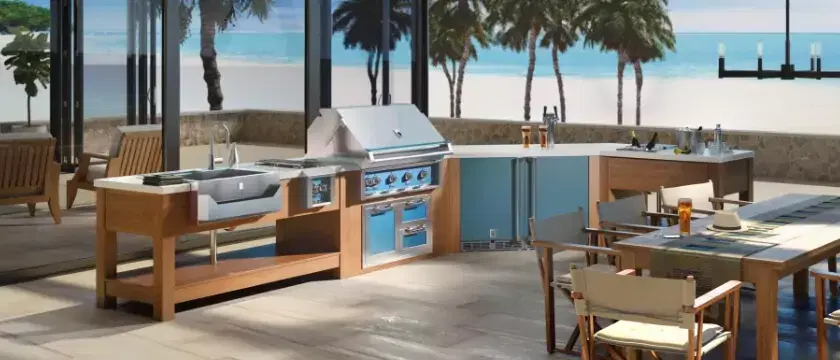
An ultra-luxury grilling experience not only means that your grill is made from commercial-grade, high-performance materials, but it also includes special features that make grilling easier, more enjoyable, and more versatile. Here are some special features and add-on accessories to consider:
Lighting: Leading brands, such as Alfresco and Lynx, outfit the surface of their grills with halogen lights, which can handle extremely high temperatures and make it much easier to cook outdoors after sunset. “Lighting is very important,” says Gardo. “Even if you have lighting outdoors, you still want an intense light so you can see what’s happening with your food and if you need to flip your steak.” Many luxury grills also feature control knobs or front panels with LED illumination, which look beautiful and make it easy to see where the knob is pointing.
Colored accent panels: Brands such as Hestan and Alfresco offer optional colored panels in the center of each door and drawer. Choose from a variety of hues to fit your style.
Hood lift assist: A lift assist allows for the grill lid to be easily opened while keeping you safely away from the flame. This is especially helpful if the hood is heavy-duty or double-walled, which keeps heat inside the grill but makes the hood rather heavy.
Storage center: Some gas grills on carts may come with storage centers, which offer a convenient place for grilling tools or accessories.
Rotisserie: A rotisserie allows food to be cooked on a rotating spit (a rotisserie). This is most often used to cook meat slowly and evenly over the flame, resulting in a moist and flavorful meal. Some grills come with an integrated rotisserie, but you can also purchase a rotisserie kit or basket to use with your gas grill when needed.
Side burners: Side burners are a great way to add additional cooking space to your gas grill. These separate burners are typically located on the side of the main grilling area. They also offer flexibility by allowing you to cook different items at a different heat than the main grilling area. The Alfresco Grills Versa Power Cooker side burner features a specially designed grate that prevents heat loss, as well as two burners each with independent controls, and ranges from 400 - 65,000 BTUs.
Grill carts: Grill carts are freestanding structures used to store your grill and any grilling accessories. In addition to food prep areas and storage, grill carts also provide mobility, as they are equipped with wheels. Many freestanding grills come with a cart.
Smoker Box: A smoker box is a removable container that can be filled with wood chips to achieve the smoky flavor of a charcoal grill. Many of AuthenTEAK’s gas grills come with a smoker box included. All of AuthenTEAK’s ultra-premium grills come with a smoker box included.
Flat-top griddles: Flat-top griddles replace traditional cooking grates with a flat, smooth cooking surface. Flat-top grills feature a built-in flat-top, but you can also purchase flat-top griddle plate attachments for your existing grill. “You’re essentially cooking with a griddle outside,” says Gardo. “More people have gotten into it in the last few years.” From pancakes in the morning to hibachi in the evening, flat-tops provide an even heat and are ideal for cooking a variety of dishes.
Indirect roasting pod: An indirect roasting pod allows you to slow-roast on your grill by creating a barrier between food and the heat source. It is designed to hold the drip pan from the rotisserie kit to catch juices that can be used for basting.
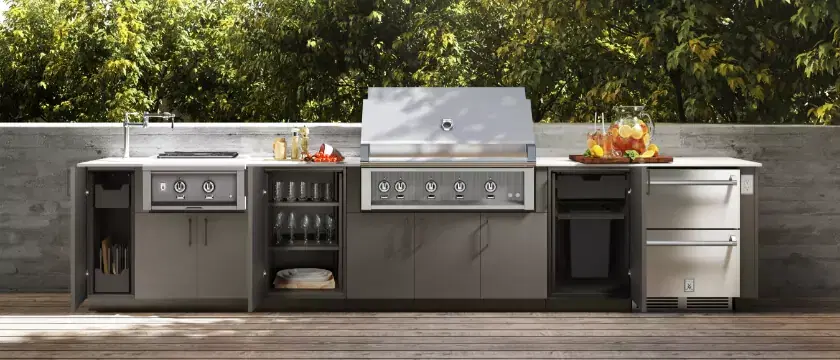
“It’s extremely rare that someone today just gets a grill,” says Urban Bonfire’s Bloom. They're typically getting a grill with a refrigeration unit, sink and faucet, and a secondary cooking device like a power burner or a pizza oven, just to name a few.”
This is part of a larger trend shift towards indoor-outdoor living, adds Bloom. “The visual connectivity between indoors and outdoors has never been as blurred as it is today,” he says. “As outdoor kitchens are becoming more of a design-driven choice, the aesthetic of appliances— just like in indoor appliances—is becoming fundamentally important in the buying decision.”
A well-designed outdoor kitchen extends your entertaining space and becomes a permanent fixture that adds value to your home. “The outdoor kitchen is not really the outdoor kitchen anymore. It’s now your other kitchen outside; it’s a secondary kitchen of the home,” Seiden says. “It’s a social, interactive space designed around a culinary center.”
Fortunately, “People do not have to sacrifice, compromise, or settle on quality, aesthetic, functionality, durability, or movability just because it’s an outdoor product,” adds Bloom. Trusted brands such as Urban Bonfire and Haven Outdoor (formerly Outdoor Solutions)—both of which are made in North America—offer design-forward, pre-assembled kitchen configurations with modular designs and customizable details. If you’re looking for a more tailor-made option, Danver and NatureKast offer customizable outdoor kitchens, and Urban Bonfire kitchens can also be fully customized.
In addition to a built-in grill, outdoor kitchens can be designed with accessories such as built-in refrigerators, trash drawers, storage, sinks, pizza ovens, side burners, and ice makers. “Just a freestanding grill outside will allow you to do one thing, and that's grill,” Seiden says. An outdoor kitchen will allow you to store, prep, cook, serve, and entertain. It’s everything you want to do inside, outside.”
For more advice on designing an outdoor kitchen, view AuthenTEAK’s Outdoor Kitchen Planning Guide.
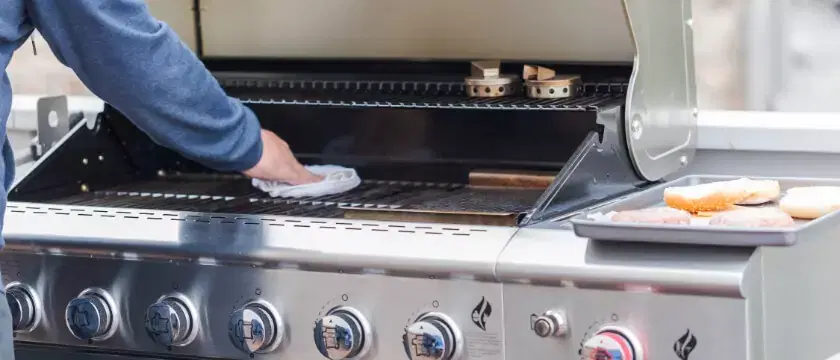
“Like a car, the more you take care of your grill, the longer it will last,” Gardo says. His tip: “For the most part, after you finish cooking, the grill is typically still warm, and that's one of the easiest times to clean it and brush off your grates.”
While stainless steel is one of the most durable materials you can place outdoors, “a common misconception is that people think stainless steel means it’s never going to get stained,” Gardo warns. “Just like anything that’s metal, you can get pollen on there, you can get water spots on there, all sorts of things. If you're not cleaning that stainless, mineral deposits will rust the grill.”
Gardo recommends cleaning the outside of your gas grill every 3-6 months with a good stainless steel cleaner or WD-40. “Look for an oily stainless steel cleaner. Before you even use a new grill, don't be scared to spray it down with that. Let the grill absorb all that oil and then wipe it all down; your grill will last so much longer.”
If you have rust deposits on your grill that you’d like to get rid of, Seiden recommends stainless steel cleaner, Bar Keepers Friend, and a microfiber cloth. “I spray the stainless steel cleaner onto the cloth and then pat in the smallest amount of Bar Keepers Friend. Then I go with the grain of the stainless steel to get the rust off.”
It’s also wise to cover your grill when it’s not in use using a high-quality grill cover designed to resist water. However, “if your grill is in a saltwater environment and you cover it, I recommend that at least once a month you remove that cover and give it a clean because salt does accumulate under the cover,” Gardo suggests.
“With the right TLC, a luxury grill can be a forever grill,” Seiden says. “Like anything else, maintenance is required.”
Categories
Recent Posts